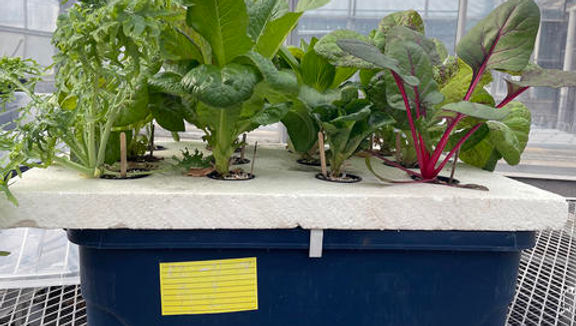
Hydroponics growing systems can seem daunting given what we may have seen or know about commercial and large-scale hydroponics; but at-home hydroponics systems can be quite simple and rewarding. When growing hydroponically, you have year-round growing potential, limited disease and insect pressure, no messy soil and even increased and quicker yields than when growing plants in soil.
The most accessible hydroponics system for the at-home grower is called the “Deep Water Culture” method. This method consists of a container, water with nutrients and a support system for your plants. This method can utilize either a passive form of aeration (also sometimes referred to as the “Kratky method” due to research done on the concept at the University of Hawaii in the 1980s) or an active form of aeration involving a pump or other method of mechanical water circulation. More information about all forms and elements of deep water culture can be found on the U of M Extension website on their Small-scale hydroponics page.
The basics elements for starting your own at-home hydroponics system are as follows:

Container: The container you choose should be opaque, clean and made of food-safe ingredients. The size depends on the mature size of your plants or how many plants you will grow in one system. The lid will be important as it will hold the net pots the plants will grow in and keep them suspended above the water. Some ideas for containers include a 5 gallon bucket with appropriately-sized holes drilled in the lid or even a recycled pasta sauce jar (the lid is the perfect diameter to hold a standard net pot) covered in an opaque material such as thick felt or foam craft sheets.
Container and growing medium: The most common type of container for your plant when using the Deep Water Culture method is a net pot. It is exactly what it sounds like: a plastic pot with holes that will hold the plant and growing medium, but also allow the root system to grow through it to reach the water and nutrients below in the container. There are many options for growing mediums in a hydroponic system, including rock wool, coconut coir, hydration, pumice or perlite. Whatever medium you choose, ensure it is clean by soaking it in water for 24 hours before transplanting your seedlings into it.

Light: Most at-home indoor hydroponics systems will require supplemental lighting-especially in winter.
Water: The first and most important element of your hydroponic water is its pH. Water should be tested for its pH levels both before and after adding nutrients. The ideal pH of hydroponic growing water is between 5.4 and 7. The second most important element of your hydroponic water is the maintenance of appropriate levels in your container. In a passive system there needs to be an air gap between the water and the beginning of the plants’ root system. The air gap is where the plants get oxygen. Generally, after the first filling—in which the water should just touch the bottom of the net pot—water should only cover up to half of the root system. Any more than this and the plants may die.
Nutrients: Because only carbon, hydrogen and oxygen are available to plants in a hydroponic system, supplemental nutrients must be added to the water. Nutrient mixes specifically for hydroponic use are easy to find and come in many varieties.
Plants to try and seed starting: The plants that do best in indoor hydroponic systems are lettuces, greens and herbs. When selecting seeds for your system, look for a hydroponics-friendly logo or signifier that many seed companies use. Seeds can be started in plugs of growing medium that will then be transplanted to the net pots when their roots peek out of the bottom.
In addition to growing hydroponically indoors, hobby gardeners can grow many crops hydroponically outdoors in the summer. Other more advanced hydroponics options exist that can be adapted to home use as well. More information on outdoor hydroponics and advanced hydroponics systems such as nutrient film or drip systems can be found on the U of M Extension website on their Small-scale hydroponics page. This page has links to external and researched sources of information as well.
If the supply resources and information available on the internet is overwhelming, there are several companies in the Twin Cities metro that can provide in-person guidance to get your own at-home hydroponics system started; for example: Ecogarden Supply; St. Paul and Greener Gardens; Richfield.
Photo credits: University of Minnesota Extension (1, 3), Joanna Kapke (2)


